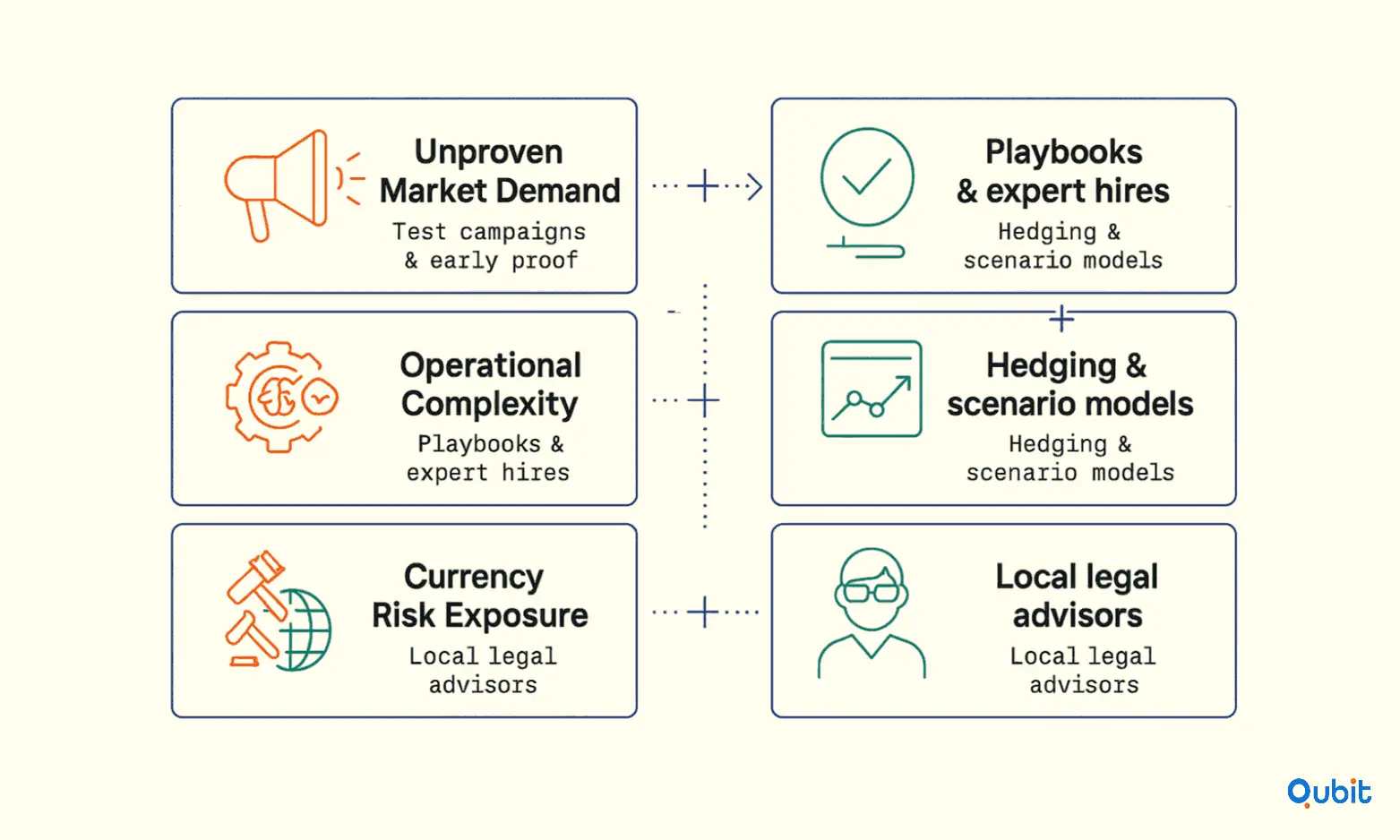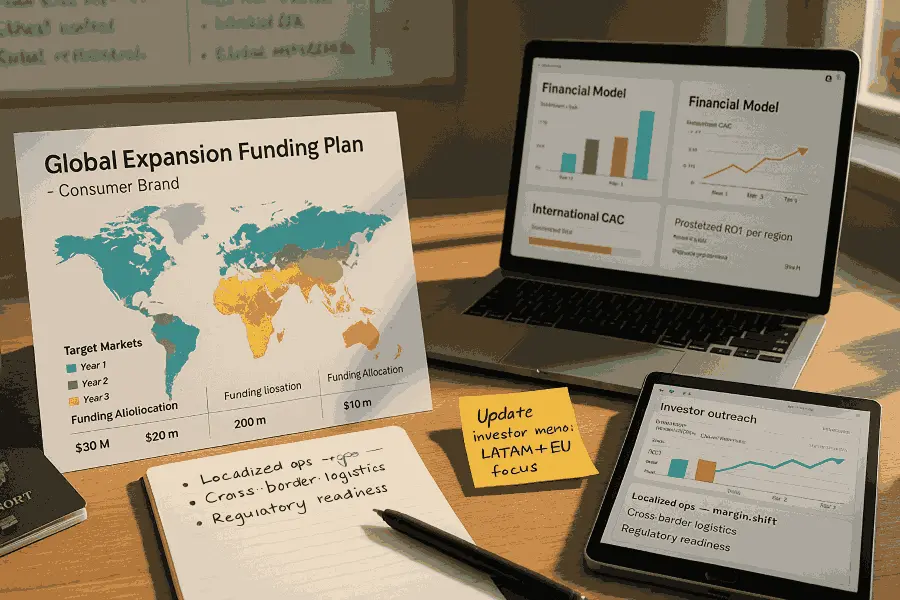Recent research reveals that startups venturing into global markets raise an average of $60 million, significantly outpacing the $20 million typically secured by companies that remain local. This dramatic funding differential reflects investor recognition that international expansion creates multiple pathways to value creation while demonstrating management's ability to execute complex growth strategies.
The statistics supporting international expansion are compelling: globally-focused startups experience a 17% boost in investor interest, achieve a 67% greater likelihood of successful exit strategies, and enjoy 3.5 times higher chances of reaching unicorn status compared to their domestically-focused counterparts.
As domestic markets become increasingly saturated and competitive, the ability to secure capital for global growth distinguishes ambitious startups from those constrained by geographic limitations.
The International Expansion Imperative
Financial Benefits Drive Investor Interest
The financial advantages of international expansion extend far beyond increased revenue opportunities. Consumer startups that successfully expand globally demonstrate several characteristics that attract premium investor attention and higher valuations.
Key Financial Advantages:
- Diversified Revenue Streams: Multiple geographic markets reduce dependence on single-market economic fluctuations
- Enhanced Valuation Multiples: Global presence commands median valuations 40% higher than domestic-only companies
- Accelerated Growth Trajectories: Access to larger total addressable markets (TAM) enables faster scaling
- Strategic Exit Opportunities: International presence creates more potential acquirers and IPO markets
Market Dynamics Favoring Global Consumer Brands
The convergence of digital infrastructure and consumer behavior globalization creates unprecedented opportunities for consumer startups to achieve international scale efficiently. Modern consumers increasingly discover and adopt products through digital channels, reducing traditional barriers to international market entry.
Enabling Trends:
- Digital-First Consumer Discovery: Social media and e-commerce platforms enable global brand awareness
- Cross-Border E-Commerce Growth: Established logistics and payment infrastructure support international sales
- Cultural Convergence: Global media consumption creates shared consumer preferences across markets
- Mobile-First Adoption: Smartphone penetration enables direct-to-consumer relationships worldwide
It’s easy to overlook how differently marketplace and consumer business models perform under funding pressure—the funding guide for consumer & marketplace startups helps clarify the trade-offs.
Funding Sources for International Expansion
Venture Capital for Global Growth
Venture capital firms increasingly prioritize startups with international expansion capabilities and strategies. The funding landscape has evolved to favor companies that can demonstrate scalable business models across multiple markets rather than single-geography success stories.
VC Characteristics Seeking Global Expansion:
- Portfolio Diversification: International startups provide geographic risk distribution
- Higher Return Potential: Global markets offer larger exit opportunities and valuations
- Competitive Differentiation: International presence creates defensive market positioning
- Investment Thesis Validation: Global success proves universal product-market fit
Leading International Expansion VCs:
- General Atlantic: Focus on growth equity for consumer companies with global potential
- Index Ventures: European-based fund backing international consumer technology
- DST Global: Specializes in growth-stage companies expanding internationally
- Felix Capital: Consumer-focused fund supporting European brands' global expansion
Alternative Funding Mechanisms
Beyond traditional venture capital, consumer startups can access diverse funding sources specifically designed to support international expansion initiatives.
| Funding Type | Typical Amount | Best Use Cases | Key Benefits | Considerations |
|---|---|---|---|---|
| Export Financing | $500K - $10M | Physical product expansion | Government backing, low rates | Requires established sales |
| Revenue-Based Financing | $1M - $25M | Marketing and inventory | No equity dilution | Higher cost of capital |
| Strategic Corporate Investment | $5M - $100M | Market entry partnerships | Industry expertise, distribution | Strategic limitations |
| Crowdfunding | $100K - $5M | Brand building, validation | Market testing, community building | Marketing intensive |
| Government Grants | $50K - $2M | R&D, market entry support | Non-dilutive capital | Compliance requirements |
Crowdfunding for International Consumer Brands
Crowdfunding platforms offer unique advantages for consumer startups seeking international expansion capital while simultaneously validating product-market fit across multiple geographic markets.
Strategic Crowdfunding Benefits:
- Global Market Validation: Campaign performance indicates international demand
- Brand Building: International exposure builds awareness across target markets
- Community Development: Creates early adopter communities in new geographies
- Distribution Insights: Pre-orders reveal optimal market entry sequences
Leading International Crowdfunding Platforms:
- Kickstarter: Global reach with strong consumer product focus
- Indiegogo: Flexible campaign structures for international shipping
- Crowdcube: Equity crowdfunding for European market expansion
- SeedInvest: US-focused equity crowdfunding with institutional participation
Strategic Approaches to International Expansion Funding
Market Entry Models and Capital Requirements
Different international expansion approaches require distinct funding strategies and capital allocation frameworks. Consumer startups must align their chosen market entry model with available funding sources and investor preferences.
Direct Market Entry
- Capital Requirements: $2M - $20M per major market
- Timeline: 12-24 months to establish operations
- Investor Appeal: Demonstrates commitment and control
- Risk Profile: Higher upfront investment, greater long-term returns
Partnership-Based Expansion
- Capital Requirements: $500K - $5M per partnership
- Timeline: 6-12 months to launch through partners
- Investor Appeal: Capital efficient, reduced risk
- Risk Profile: Lower investment, potential control limitations
Digital-First International Launch
- Capital Requirements: $250K - $2M for marketing and logistics
- Timeline: 3-6 months to launch e-commerce presence
- Investor Appeal: Rapid market testing, low barriers
- Risk Profile: Minimal investment, limited market penetration
Phased Funding Strategies
Successful international expansion typically requires staged capital deployment aligned with market validation milestones and operational complexity scaling.
Phase 1: Market Research and Validation ($250K - $1M)
- Comprehensive market analysis and competitive landscape assessment
- Regulatory and compliance research for target markets
- Initial customer discovery and product-market fit testing
- Partnership identification and preliminary negotiations
Phase 2: Pilot Market Launch ($1M - $5M)
- Limited market entry with focused customer segments
- Marketing campaign development and execution
- Supply chain and distribution network establishment
- Performance measurement and optimization
Phase 3: Full Market Expansion ($5M - $25M)
- Comprehensive market penetration and brand building
- Operational infrastructure scaling and localization
- Team development and local market expertise acquisition
- Additional market expansion based on initial success
Investor Evaluation Criteria
Demonstrating International Expansion Readiness
Investors evaluating international expansion funding focus on specific indicators that predict successful global scaling rather than just domestic market success.
Critical Evaluation Factors:
Market Opportunity Analysis
- Total addressable market size and growth projections across target geographies
- Competitive landscape assessment and differentiation strategies
- Cultural adaptation requirements and localization capabilities
- Regulatory and compliance complexity management
Operational Scalability
- Technology infrastructure capable of supporting multiple markets
- Supply chain and logistics flexibility for international shipping
- Customer service capabilities across time zones and languages
- Financial management systems for multi-currency operations
Team Capabilities
- International experience among founding team and key executives
- Cultural competency and local market understanding
- Partnership development and management expertise
- Execution track record in complex operational environments
Knowing who’s actively writing checks in your vertical isn’t optional. This list of top investors backing consumer & marketplace startups helps cut through outdated intros.
Financial Modeling for International Expansion
Sophisticated financial projections become essential for attracting international expansion capital, requiring models that account for market-specific variables and phased growth trajectories.
Market-Specific Unit Economics
- Customer acquisition costs by geographic market and channel
- Lifetime value calculations accounting for local spending patterns
- Currency fluctuation impact on margins and profitability
- Localization costs and ongoing operational expenses
Phased Revenue Projections
- Market penetration rates based on competition and market maturity
- Revenue ramp timelines reflecting operational complexity
- Cross-market synergies and brand value transfer
- Scenario modeling for different expansion sequences
For consumer startups especially, repeat usage speaks louder than downloads. The breakdown on proving retention and ltv to secure funding helps frame that for investors.
Success Factors and Best Practices
Building Investor Confidence
Consumer startups seeking international expansion funding must demonstrate both market opportunity awareness and operational execution capabilities to secure investor commitment.
Proven Success Strategies:
Domestic Market Excellence
- Strong unit economics and customer retention in home market
- Scalable operational systems and technology infrastructure
- Brand recognition and customer loyalty demonstrating transferable value
- Management team experience with complex operational challenges
International Market Preparation
- Comprehensive market research and competitive analysis
- Early customer discovery and product-market fit validation
- Partnership discussions and potential collaboration frameworks
- Regulatory compliance understanding and legal structure planning
Execution Track Record
- Previous successful market expansion or complex operational initiatives
- Team members with international business development experience
- Advisory board inclusion of relevant international market experts
- Strategic partnership agreements or letters of intent
Cultural and Operational Adaptation
Successful international expansion requires balancing brand consistency with local market adaptation, a complexity that sophisticated investors evaluate carefully.
Adaptation Framework:
- Product Localization: Features, pricing, and positioning adapted to local preferences
- Marketing Localization: Messaging, channels, and creative content culturally relevant
- Operational Localization: Customer service, payment methods, and fulfillment options
- Partnership Integration: Local market expertise through strategic relationships
Case Study Analysis
Consumer Brand International Success
Revolut's international expansion demonstrates the funding trajectory possible for consumer-focused startups with global ambitions. The UK-based fintech company successfully raised over $900 million across multiple funding rounds to fuel its international growth.
Funding Timeline and Strategy:
- Series A (2016): $8.4 million from Balderton Capital and Ribbit Capital for initial product development
- Series B (2017): $66 million from Index Ventures for European expansion
- Series C (2018): $250 million from DST Global for global market entry
- Series D (2020): $500 million from TCV for comprehensive international scaling
Results: Revolut expanded across Europe, North America, and Asia, acquiring over 15 million customers globally and achieving a $5.5 billion valuation.
Key Success Factors:
- Staged funding aligned with expansion milestones
- Investor selection based on international expertise and networks
- Technology-first approach enabling rapid market replication
- Strong unit economics in initial markets before expansion
Implementation Framework
12-Month International Expansion Funding Timeline
Month 1-3: Foundation and Research
- Conduct comprehensive market analysis for target geographies
- Develop detailed financial models and funding requirements
- Begin investor research and relationship building
- Establish advisory board with international expertise
Month 4-6: Pilot Market Validation
- Launch limited market entry in one target geography
- Gather performance data and customer feedback
- Refine expansion strategy based on initial results
- Prepare investor materials with validation data
Month 7-9: Active Fundraising
- Begin formal investor outreach and pitch meetings
- Negotiate term sheets with interested investors
- Complete due diligence processes efficiently
- Secure funding commitments for expansion phases
Month 10-12: Capital Deployment
- Execute expansion plans with secured funding
- Implement operational infrastructure for multiple markets
- Build local teams and partnership relationships
- Establish performance measurement and reporting systems
Common Challenges and Solutions

Consumer startups face unique challenges when seeking international expansion capital that require strategic approaches to overcome investor concerns.
Challenge: Unproven International Market Demand
Solution: Implement digital marketing tests and pilot campaigns in target markets to demonstrate demand before formal expansion. Use crowdfunding campaigns to validate international interest while building brand awareness.
Challenge: Operational Complexity Concerns
Solution: Develop detailed operational playbooks and partner identification strategies that demonstrate systematic approaches to international market entry. Hire experienced international business development advisors.
Challenge: Currency and Economic Risk
Solution: Implement currency hedging strategies and develop scenario models showing performance under various economic conditions. Focus on markets with stable currencies and economic conditions for initial expansion.
Challenge: Regulatory and Compliance Complexity
Solution: Engage local legal experts early in market research phases to understand requirements fully. Budget appropriately for compliance costs and build timelines that accommodate regulatory approval processes.
For LPs and founders alike, mapping likely exits sharpens every upstream decision. This exploration of exit strategies in consumer & marketplace investing ties that thinking together.
Future Trends and Opportunities
The evolution of digital infrastructure and changing consumer behaviors create new opportunities for consumer startups to achieve international scale more efficiently than previous generations.
Emerging Opportunities:
- Social Commerce Integration: Leveraging global social media platforms for direct international sales
- Creator Economy Partnerships: Collaborating with international influencers for market entry
- Subscription Model Globalization: Recurring revenue models that scale efficiently across markets
- Sustainable Brand Positioning: Environmental and social consciousness as universal brand differentiators
Technology-Enabled Expansion
Advanced technology platforms increasingly enable consumer startups to achieve international presence without traditional operational complexity and capital requirements.
Technology Enablers:
- AI-Powered Localization: Automated content and experience adaptation for different markets
- Cross-Border Payment Solutions: Simplified international transaction processing and currency management
- Global Logistics Networks: Third-party fulfillment enabling worldwide product distribution
- Remote Team Management: Cloud-based systems supporting international team collaboration
Conclusion
Raising capital for international expansion is a pivotal milestone for consumer startups aiming to scale globally and capture diverse markets. Successful expansion requires not only adequate capital but strategic planning encompassing market research, operational scalability, and cultural adaptation. Aligning with investors who possess global experience and networks further accelerates growth and mitigates risks associated with cross-border entry.
If you’re tired of endless searching, discover our Startup Matchmaking service and let us introduce you to your next big opportunity.
Key Takeaways
- Consumer startups expanding internationally raise $60M on average vs $20M for domestic-only companies, with 17% higher investor interest.
- International expansion funding requires staged capital deployment from $250K market research to $25M+ full expansion phases.
- Multiple funding sources exist beyond VC including export financing, revenue-based funding, crowdfunding, and strategic corporate investment.
- Investor evaluation focuses on market opportunity analysis, operational scalability, team capabilities, and sophisticated financial modeling.
- Success requires balancing brand consistency with local market adaptation while demonstrating execution capabilities and cultural competency.
Frequently asked Questions
What funding amount should consumer startups expect for international expansion?
Consumer startups typically need $2-20M per major market for direct entry, $500K-5M for partnership-based expansion, or $250K-2M for digital-first approaches






